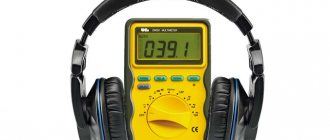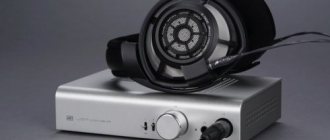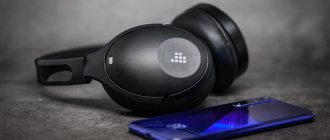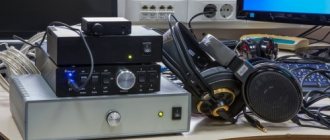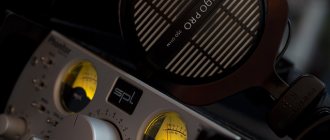Most music lovers think that by wearing an audio accessory with the highest number of ohms and “hefty” cups, they will be able to achieve optimal sound. At the same time, not paying attention to the device from which the sound comes. However, this is the opinion of non-professionals. In reality, things are different.
Symbol representing resistance
What does impedance mean?
Regardless of the type of device that is used to supply sound, each has an amplifier. It is responsible for generating oscillations in the output voltage of sound waves. Due to this, the dynamic heads transmit sound. However, average voltage values vary greatly depending on the device.
On smartphones, the audio amplifier has a rating of 200 milliVolts.
Impedance is the average value of resistance that varies with frequency.
Portable amplifier for optimal sound
High-impedance headphones are used not only by professional musicians, but also by simple music lovers . In order to listen to music at a sufficient volume, you need to match the power of the speakers to the device. In this case, absolutely all frequencies are reproduced, and the sound is of high quality. A portable headphone amplifier helps solve this problem - it provides high fidelity sound reproduction.
The operating principle of the amplifier is as follows: due to the high impedance in the headphones, the device delivers less current, which prevents frequency distortion of the individual stages. The high-impedance headset has uniform amplitude and frequency characteristics due to the use of an amplifier.
To avoid deterioration in the quality of headphones and their rapid wear, when purchasing equipment, pay attention to the impedance. Which one is better depends on the devices they will interact with. This parameter must correspond to the audio equipment model and listening device. The resistance of different types of headphones affects the sound quality and ensures stable operation of the audio device.
High and low resistance
Based on resistance, headphones are divided into two types. The boundary is different for full-length and in-ear devices.
| Headphone type | Resistance value, Ohm | |
| Low resistance | High resistance | |
| In-canal | Up to 32 | Over 32 |
| Full size | Up to 100 | Over 100 |
Power and quality
The manufacturer may assume normal sound quality at the specified output power level. This is not always the actual maximum power that the amplifier is capable of delivering or at which the headphones should fail. The total power value for a lower quality mode can be much higher. Those. The manufacturer indicates that the headphones will play with predicted good quality at this supplied power, but they can withstand higher values.
Which ones to choose
When choosing based on impedance in headphones, you need to consider the technique that will be used. Any device has an amplifier. To avoid sound distortion, the headphones must be matched to the source. When choosing an audio accessory, you need to rely on the 1/8 rule.
The source impedance must be less than 1/8 of the accessory impedance. For example, for devices with 16 Ohms, the output impedance on the phone should not exceed 2 Ohms. Otherwise, the accessory will provide poor sound quality.
For phone, laptop or player
This category of devices belongs to compact ones. For this reason, it is recommended to purchase earbuds that are small in size. When choosing, you should consider the output voltage level of the device, as well as the power consumption and impedance of the headphones.
Just a little bit of theory If we briefly answer the question posed, the answer would be like this: The reason lies in the unequal values of the output signal level on different devices that are used to listen to music with the same headphones.
A smartphone, a computer or a top-end cinema - each of them has an amplifier at the output, the task of which is to generate fluctuations in the audio frequency (AF) output voltage. These voltage fluctuations cause the dynamic heads to emit sound waves. But the average output voltage level is far from the same for different classes of devices. The AF amplifier of a smartphone produces an average of 200 mV (milliVolts), and the Hi-End class head unit can operate at units of Volts and even more! Headphones connected to the ultrasonic frequency output have a specific value of active and reactive resistance for different frequencies of the applied voltage. The average value of the sums of these resistances is called impedance.
For simplicity, and so as not to accidentally proceed to calculating your ultrasonic frequency with ideal parameters, and then not get bogged down in impedance matching, we will assume that the sum of the internal resistances of the headphones is a constant over the entire frequency range. In full accordance with Ohm's law, they will sound differently on different devices, because different voltage values will be applied to them, and we consider impedance to be a constant and unchanging value. This means that under such conditions, an unequal amount of current will flow through the driver or dynamic head, to which the headphones will respond by decreasing or increasing the volume level. The problem of choice Among thousands of models of different types with a unique combination of characteristics, it is easy to get confused, but let’s leave aside the entire set of their advantages and disadvantages, dividing them into groups taking into account only one parameter - resistance. Its value for products ranges from 8 to 600 Ohms, but for example, let’s take the most popular and affordable ones - channel in-ear headphones with an impedance from 16 to 64 Ohms, because once you understand the main principle, you will be able to navigate the choice of these accessories for any device. Headphones for a smartphone A mobile phone is a compact thing and the normal adequate solution is to choose earbuds that take up less space compared to older models. But in the context of the review, it is more correct to start not from their size. To compare parameters such as volume, power consumption (not the last argument for a gadget with a battery), sensitivity, it is important to know the range of resistance values of the earbuds, as well as the voltage level at the output of the smartphone’s ultrasonic filter. Neither one nor the other group of characteristics is a secret: The average impedance value for the selected group is from 16 to 32 Ohms, although models with a resistance of 64 Ohms are also produced; An ordinary smartphone rarely boasts an output voltage of more than 200 mV.
Volume and power To assess the degree of influence of impedance on the quality of the experience of listening to music, first, let's calculate the current that will flow in the emitter. The volume of the sound, as well as the power consumption, depends on its value. Let's take the most common 16 Ohm models and see that: If I (current) = U (ex.) / R (resistance) then for the most common models, with the maximum volume mode on the smartphone (output 200 mV), the current value will be:
I(A)= 0.2V/16Ohm = 0.0125 A or 12.5 mA
But if you connect a 32 Ohm model, then the current will flow exactly half as much:
I(A)= 0.2V/32Ohm = 0.00625 A or 6.25 mA
This means that higher impedance headphones will be noticeably quieter. We count the power: W(power W)=I(current, A)*U(ex. V)
With an impedance value of 16 Ohms, the maximum consumption will be 2.5 mW, and 32 Ohms - 1.25 mW. For the buyer, this means that high-impedance headphones will sound quieter, but use battery power more economically. Low-impedance ones, on the contrary, are much louder, while consuming more current; although not by much, they reduce the battery life of the smartphone. Sensitivity First of all, this is a characteristic that indicates how the sound pressure level (volume) will change when the input signal changes by a certain amount. The higher the sensitivity characteristic, the louder the headphones sound. However, too much sensitivity will add the amplifier’s own noise and electrical interference of various natures to the music.
Understanding the degree of influence of resistance on sensitivity is a little more difficult - the fact is that not all manufacturers inform the consumer about the value of sensitivity, and it depends on impedance. In the best case, the sensitivity is indicated on the box without any units of measurement at all, but sometimes dB/mW is indicated - in these units the ratio at all frequencies will be the same. Perhaps this is easier for the average buyer, but linking sensitivity to power will not help in the choice at all!
By changing the volume using controls on your phone or amplifier, you do not change the power, but only the output voltage level. To be able to use the word “power” at all, you need a consumer.
To confirm these words, perform a thought experiment - turn the volume control to maximum in an amplifier with connected acoustics. Has the power increased? Great. Now disconnect the speaker wires and turn the controls - how does the power change? No way. The resistance of the consumer circuit tends to infinity. No current flows. No power. Therefore, by connecting headphones with different impedances to the ultrasonic output, you are guaranteed to receive divergent amplifier power values. This suggests that 16-Ohm headphones with a sensitivity of 97 dB/mW, which are required to produce 97 dB of sound for each mW spent, and the same 32-Ohm accessory with a similar sensitivity, when connected to the same source, will definitely work with different actual volume level, producing different power.
Thus, 32-Ohm headphones sound noticeably quieter, because to provide the same current at different resistances, you need to apply different voltages, and it may not be enough at the ultrasonic output. How not to make a mistake Ideally, to select headphone impedance for a specific technique, you need to know the maximum voltage level that is possible at the ultrasonic sound output without distortion. With this information in hand, it is fairly easy to calculate current values and actual power for headphones with different impedances. But, if it is not possible to make a calculation, then you can remember a simple solution: lower impedance headphones will provide a higher volume level at high sensitivity (noise and distortion are possible). An ideal solution for smartphones and players where the output voltage of the ultrasonic amplifier is limited. high-impedance ones - will be noticeably quieter at low sensitivity (interference simply cannot affect the sound, their amplitude is too small for this), but require an amplifier with a high output voltage level - a good solution for stationary equipment.
Characteristic values for different types of headphones
In-canal
Most have a flat curve with values from 16 Ohms to 32. This category is characterized by the absence of deviations in the range from 20 to 20 kilohertz.
Full-size and overhead
Most full-length and over-ear models have an uneven curve. They are distinguished by a significant rise at low frequencies and a slight rise when playing high frequencies. The value is often equal to 32 Ohms, if you do not take into account the reactive part.
Unevenness indicates design features of the emitter or resonances. The lift may vary depending on the position of the device.
Some models are characterized by the absence of deviations. With these headphones it is better to use a low output impedance. This is explained by better control at 20 - 1 kHz.
Reinforcement
The impedance of an accessory with an armature radiator is quite difficult to predict. Single-driver models are distinguished by their rise at high and mid frequencies. This ensures clear sound at high and very high levels. The amplifier creates less distortion. The standard value at low frequencies is about 25 ohms. From 500 Hz rises are observed. If an accessory indicates an impedance of 100 Ohms at 1 kHz, this does not mean that the model is high-impedance. At low frequencies the value will be about 16 ohms.
Planar
The category implies an isodynamic emitter. Has a straight line. In theory, this is the optimal load for the amplifier. However, at high frequencies the impedance gradually decreases to 0. This has a negative effect on the sound.
Technical characteristics, general concepts
Main physical and technical parameters affecting sound quality and volume:
- Reproducible frequency range.
- Impedance (resistance).
- Power.
- Nonlinear distortion (degree of distortion).
- Headphone sensitivity.
Recommendations: 9 Best Vacuum Headphones
What is the best headphone impedance?
, Technical characteristics of good headphones
Range
The human ear mainly perceives a frequency component in the range of 20~20000Hz. Some more, some less, depends on the anatomical features of the auricle and the sensitivity of the hearing organs. With age, the ear recedes, especially at the upper border.
On the other hand, the full spectrum of frequencies is important for people associated with music - composers, sound engineers, artists and music lovers. Such properties are typical for professional or high-quality household products. The spectrum is 5~42000Hz, which allows you to reproduce sound with the highest possible purity.
Resistance
Or impedance, an indicator of the nominal resistance at the headphone input. The full parameter consists of two components, resistive and reactive. The value is directly related to the resonant frequency.
The resistance of the headphone is interconnected with the output parameters of the signal source. That is, portable equipment (smartphone, player, tablet) is limited in terms of output voltage, but is loyal in terms of current level. Therefore, it is advisable to select low-impedance headphones.
Stationary equipment, with a more powerful signal, allows for varying the voltage value. Hence, it is preferable to use high-impedance headphones.
Power indicators
The generalized power rating of headphones is in the range of 1~5000mW. Inconsistency with the parameters of the electrical signal source - exceeding - can lead to failure of the reproducing device.
To obtain high-quality sound from a smartphone or radio player, a few milliwatts are enough. Using higher settings will quickly drain battery power. In addition, the sound will become defective in frequency, and significant signal distortion will occur. Hence, the high sensitivity of the headphones compensates for the seemingly insufficient playback power.
Powerful designs can be safely used with stationary signal sources. The built-in amplifier will provide the required level. The sound will be clear and high quality.
5 best headphones under 1000 rubles
Degree of distortion
The design of headphones cannot provide one hundred percent sound quality. A deviation from standard indicators of less than 0.5% is considered high-quality reproduction. An indicator of 0.5~2.0% indicates average and mediocre sound.
Sensitivity
The characteristic reflects the sound volume of the headphones. The parameter is measured in decibels (dB). The upper threshold is in the range of 100~120dB. The strength of the sound is determined by the size of the magnetic core; the larger it is, the more sensitive the headphones are.
It is clear that mini devices have small core dimensions. Hence, earbuds, tablets, and vacuum headphones have a low sensitivity threshold. The sensation of loud sound is achieved by placing the membrane close to the eardrum. Overhead and full-length designs have a larger core and a larger flexible membrane. Accordingly, they have increased power and sensitivity.
The same signal applied to different types of headphones will not be reproduced in the same way. Louder with higher sensitivity, quieter with lower threshold. In the accompanying documentation, the manufacturer usually reflects the parameter values. But there is no single standard. Therefore, seemingly identical devices at first glance sound with excellent volume from different manufacturers.
Myth #5: Expensive headphones require an expensive sound card
A typical situation: a user buys expensive headphones, inserts them into his computer, and hears something unintelligible. Oddly enough, in most cases this is due to the wrong choice of sound card output. If you open the Datasheet for an already outdated Realtek 1150, you can see:
Of course, nothing prevents the manufacturer from changing the result, either for the worse or for the better. Therefore, we check the impedance of the sound card ourselves, using a resistor and a multimeter. To do this, it is enough to measure the voltage under load and without, and calculate the internal resistance of the output based on the measurement results:
But, what’s more interesting is that the resulting frequency response of headphones depends much more on how they sit on the head, as well as on the condition of the ear pads.
The gray graph is the result of 5 measurements depending on the position on the head - the difference reaches 5 dB or more. Against this background, a change of several decibels in the internal resistance of the sound card is not a reason to panic.
A clear demonstration of the reason for the appearance of angry comments about headphones that have been on the market for a long time. The user buys new headphones to replace broken old ones, and hears the difference. But the reason is not a bad model, but sagging ear pads.
Much more important is the loss of bass due to the inability of the amplifier to deliver the required current. To check this, you can use the RMAA program and the second half of the improvised stand:
It looks even more confusing in real life:
The test results show that the Realtek 1220 made by Gigabyte does not lose bass.
And the level of distortion is beyond the capabilities of the human ear, even if you do not take into account the fact that the recording was made to a linear input, which introduces additional distortion
Myth No. 3: the higher the impedance, the more powerful the source is needed
For headphones to be comfortable to use, they must produce a certain volume level. For example, 95 dB SPL, as the most suitable for listening to music without the risk of hearing damage.
Since ohms, watts and volts, and decibels are interconnected, it is not difficult to deduce one from the other:
But, of course, no one will count this, so you can use the sign for 95 dB SPL:
The table clearly shows that ohms are not the most important parameter here. Headphones have such a spread in sensitivity that the spread of the required power to achieve the desired volume becomes large. But when choosing an amplifier, the main parameter here is sensitivity not to power (dB SPL/mW), as most manufacturers indicate, but to voltage (dB SPL/V). Using it, it is very easy to determine how many volts the source must supply to the headphones in order to obtain the required sound pressure.
In order to select a source for your headphones a little better than at random, you will need to know the voltage it produces.
An error in selection here means not only insufficient volume, but also damaged headphones.
To be on the safe side, you will need manufacturer's documentation or a review. Most likely the watts will be indicated: mW, dBm; or voltage units: Vrms, Vpk, Vpp, dBu, dBV (one can only dream of the existence of some common standards).
The dBV, dBu and dBm missing from the diagram are already on a logarithmic scale. Unlike conventional audio dB, where the reference point is the sound pressure of the hearing threshold, for dBV it is 1 volt, for dBu it is the voltage required to produce 1 mW of power into a 600 Ω load, rounded to 0.775 V (but only for sound, in other areas the starting point will be different).
In most cases, phones and players, with the exception of flagship and Hi-Res ones, are capable of producing no more than 0.4 V RMS, built-in sound cards 0.7–2.2 V RMS, external 7 V RMS, budget professional sound cards 3–16 dBu . But a stationary Hi-Fi can supply headphones with 50 V RMS. And it's not a joke.
It would seem that all you have to do is calculate the required voltage, look at the plate, and you can confidently say which headphones will be sufficient with a simple sound card, and which will require a really powerful amplifier.
But headphone manufacturers are not so simple. Everyone has their own method for measuring sensitivity and impedance, starting from the choice of frequency or frequency band for measurements, ending with what goes into the final result: the maximum or average value, which (in)by the way can be calculated in several ways. Therefore, there is no way to do this without independent reviewers.
Now let's move on to answering the question from the beginning. To achieve 94dB SPL using a Sennheiser HD 650 with a sensitivity of 103 dB SPL/V and an impedance of 300 Ω, only 0.279 V RMS and 0.225 mW are required. Most portable equipment will provide this, but on the street, and especially in the subway, this will not be enough due to the high noise level and lack of sound insulation, because open-back headphones are not for the street.
On the other hand, a Shure 1840 with a sensitivity of 96 dB SPL/mW and an impedance of 65 Ω requires 0.506 V RMS and 3,800 mW to achieve the same volume. That is, to obtain the same volume level, equipment of a higher class is required. And don’t let such modest numbers confuse you - in operational applications, when high sound levels are required, not every source can deliver the required power without loss of bass or amplitude limitations. This was the source for the next myth.
Content
When choosing headphones, the buyer often finds himself captive of myths born from a lack of understanding of what to do with the declared parameters. And especially impedance, because the headphone’s partner is the source amplifier, which has to work with all this.
To answer the question “When is a more powerful amplifier needed?” It must be understood that the fashion for power comes from stationary acoustics, the bulk of which falls within the impedance range of 4–8 Ω. The large size of the speakers does not allow engineering thought to go wild in terms of other parameters, while most headphones have an impedance from 16 to 600 Ω. According to the logic of stationary acoustics, the more watts, the louder. And everyone knows from a physics course that the greater the resistance, the less watts will go into the load. As a result of these simplifications, even professionals often mistakenly believe that this will work with headphones.
Myth #2: Impedance can be measured with a multimeter
Unfortunately, this method can only measure DC resistance. Impedance is only expressed in ohms, as if, instead of an actual load, a resistor was included in the circuit to produce the same current. A simplified electrical model of a speaker looks like this:
It is impossible to measure all this with a multimeter using it as an ohmmeter. But this can be done by a computer sound card using the REW program according to the following scheme:
And based on the measurement results, you will get a graph of impedance and electrical phase:
How such a graph is converted by the manufacturer into a single figure can only be guessed at.
